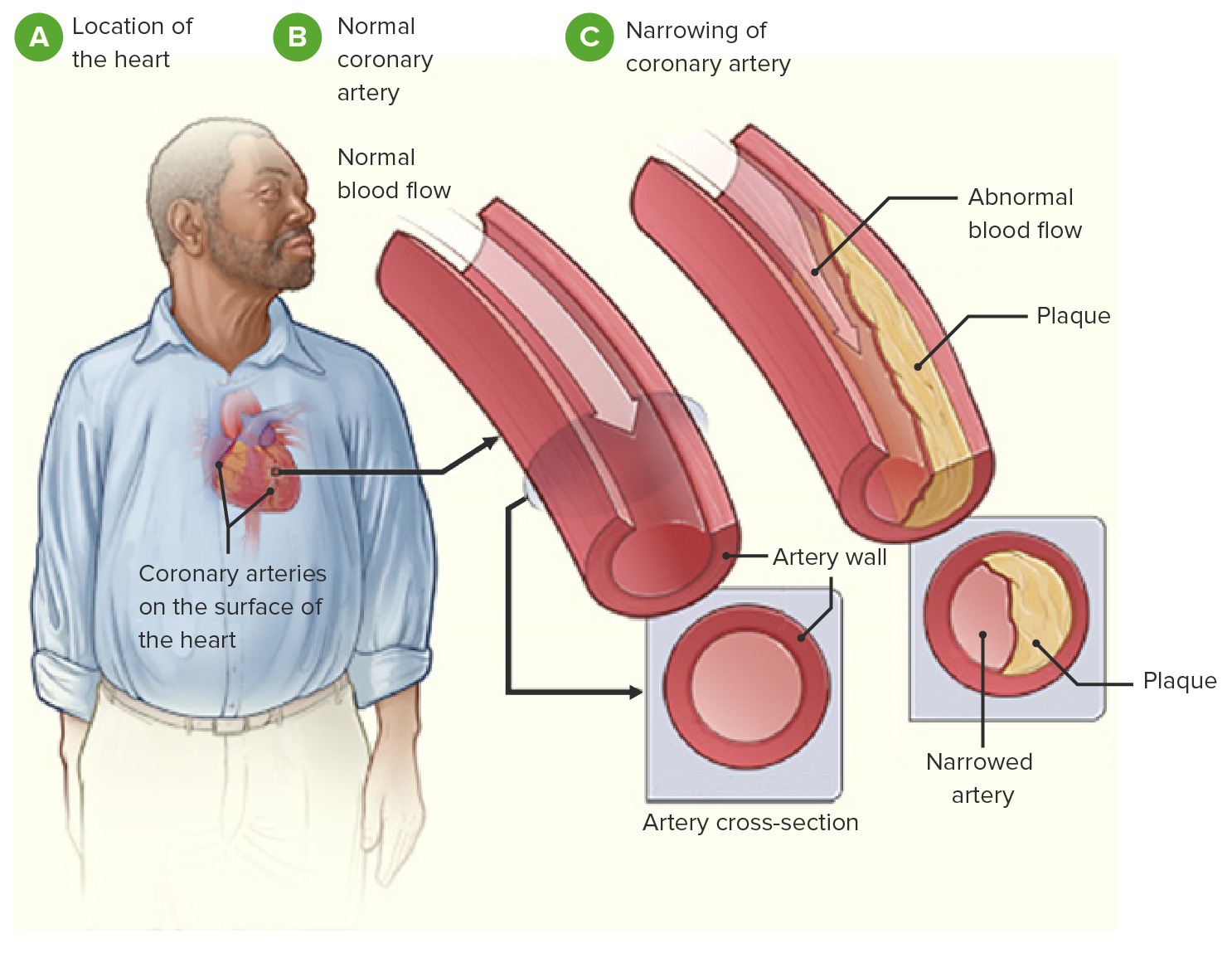Playlist
Show Playlist
Hide Playlist
Acute Coronary Syndrome – Coronary Artery Disease
-
Slides Coronary Artery Disease.pdf
-
Reference List Cardiology.pdf
-
Download Lecture Overview
00:00 Now, the vast majority of patients with so called chronic stable ischemic heart disease do extremely well with lifestyle management and evidence based medicines. These are the patients who develop angina or discomfort when they climb a flight of stairs or when they run up a hill. But, in fact, that anginal pain goes away when they rest for a few minutes and usually, with evidence based medicines, the number of anginal episodes is very, very small and the patients do very, very well. However, there's a group of patients who don't do so well and these are the patients with acute ischemic heart disease. There are three subdivisions of acute ischemic heart disease. There is the so called ST-elevation myocardial infarction, there's the non-ST elevation myocardial infarction and there's unstable angina as you see in the diagram here. What is the difference? The difference can be found in looking at the electrocardiogram and also looking at blood tests of substances that are released by injured or dying heart cells. So, let's talk about each of those in order. The ST-elevation MI is the worst one. That's when the artery is completely blocked, there's an area of heart and muscle, usually a substantial area that's dying and the electrocardiogram shows that the ST segment of the electrocardiogram is elevated. I'm going to show you an example in a moment. 01:28 The non-ST elevation MI, the patient may have the same symptoms that is severe discomfort at rest, sweating and so forth, but the electrocardiogram does not show any ST elevation. The subsequent blood tests show a smaller increase in myocardial elements with the non-ST elevation myocardial infarct compared to the ST-elevation myocardial infarct. Thus, the ST elevation myocardial infarct is bigger and more serious. With unstable angina, there's no or small EKG changes, but in fact, there's no bump in the myocardial elements that show that myocardial cells are dying. The commonest test that's done today is the troponin test. Troponin is part of the myocardial machinery and it's released when heart cells are dead or dying. 02:20 So, this gives you a little sense of the pathophysiology of acute ischemic heart disease. There's a sudden change in the blood flow, the injury can be very small or not even measurable or unstable angina can be intermediate with non-ST elevation myocardial infarction and can be quite large with an ST-elevation myocardial infarct. Here we see a little diagram of ST-elevation. I think you can see this, the little upward deflection of the ST segment in several of the electrocardiogram leads here, almost like a sort of hump on a camel and it can be associated, by the way, with cardiac arrest; you see in the right diagram, the patient being defibrillated from a cardiac arrest that resulted from an ST-elevation myocardial infarct. It's a very frightening statistic that I'm going to tell you now - 50% of patients, the first manifestation of coronary artery disease is sudden death. When it occurs in a place where there's a defibrillator available, public defibrillator, often these patients survive. When it happens at home or in a place where there's not a defibrillator available, often these individuals will die. If one sees a... 03:38 an event like this, of course, one needs to do CPR - chest compressions and of course, call for emergency help that comes with a defibrillator. If it happens at a place like a school or a ballpark where there's an emergency defibrillator, the bystanders can actually do the defibrillation themselves. Here are some more electrocardiograms, some of them showing ST-elevation - that same camel back hump increase, and some not showing it. These are all from patients with myocardial infarct where you see the camel back, the ST elevation, that's an ST elevation MI; where you don't see it, that's a non-ST elevation MI or myocardial infarct, commonly called MI. How do we make the distinction? Well, I already told you and it's shown here in this little diagram. First of all, in the top bar, patients present with ischemic discomfort. They present with this discomfort that we've talked about a number of times that's suggestive of lack of blood flow in the heart. If the electrocardiogram shows ST-segment elevation, then that can develop into what is called a Q-wave myocardial infarct that is changes in the electrocardiogram, that shows that there has been loss of heart muscle. If there is no ST elevation, it might be that the patient have unstable angina, there is no elevation in the blood troponin test, the myocardial injury test, or they might have a small bump in the enzymes and that are the troponin and that's called a non-Q wave myocardial infarct. And of course, sometimes even with ST elevation, a small number of people, the blood clot is blown downstream and these patients then go on to not a Q-wave in their cardiogram, but so called non-Q wave. 05:20 In essence, the electrocardiogram gives us a rough guesstimate of how much heart muscle is being injured. In unstable angina, without any bump in the troponin level, not much injury to the heart muscle and heart recovers. In a non-Q wave MI, usually less injury and a Q-wave MI, more injury. But interestingly enough, when you follow patients with each of these syndromes out for five or ten years, the mortality rate is the same. Why? Because the underlying disease is still there. So, maybe there's a little more risk acutely with the ST-elevation MI, but as you go down stream, the other groups catch up because the same disease process is continuing to go its course. 06:04 These acute coronary syndromes or acute ischemic syndromes are extremely common. Here are some statistics from the United States, you can see that the ST-elevation MI is about 330,000 a year, 0.33 million a year whereas the non-ST elevation or unstable angina patients about 1.24 million a year. So, lots and lots of patients with this disease and if it's not treated appropriately, the end can be heart failure or even death. So, this is really a medical emergency, it requires a coronary care unit, an experienced catheterization laboratory for opening up the arteries, doctors who understand the use of the various drugs that Im going to talk about in a few minutes. So, the bad news is having a heart attack. 06:50 The good news is that evidence based therapy does work and it markedly improves the chance that the patient will not have a second myocardial infarction and also, that they will not have symptoms that cut into their lifestyle. So, here is a list of all of the things for which we have evidence base that they really improve the situation for the patient with heart attack. Many of them are lifestyle changes and others are medications. All have been shown in carefully designed trials to improve the outlook for the patient with a myocardial infarction. And of course, when the patient goes home, what I always tell them the name of the game from here on in is no more heart attacks. And how do we do that? We do that by two things, lifestyle changes on the part of the patient and evidence based medications. 07:40 Here we see a list of all of the American Heart Association, American College of Cardiology guideline approved indications for lifestyle changes and I think they're well known to all of you. We use them in primary prevention to even try and prevent the first heart attack and we use them in secondary prevention to prevent the next heart attack - smoking cessation, control of blood pressure, regular physical activity, appropriate diet, weight control, diabetes control and so forth. In addition, we have wonderful evidence based medicines, the Statin drugs that we talked about for lowering cholesterol, the ACE inhibitors that block the renin-angiotensin system help to improve vessel function and decrease blood pressure, beta blockers that decrease the work of the heart by decreasing the heart rate. 08:27 There's a whole attack plan when the patient has any one of the acute coronary syndrome events and of course we also give platelet blocking agents that I talked about in the clinical pharmacology part to prevent another blood clot from forming in the future. This is particularly important when we put a stent, a little wire cage into the patient to keep the artery open, that can cause clot to form and we want to make sure no clot forms on that. So, patients have to take their medicines and they have to do lifestyle changes. When all of that comes together, patients live many year,s a very productive life and they do, almost all of them, do extremely well. Unfortunately, many patients decide to stop their medicines for a variety of reasons, "Oh," they say, "I don't like to take chemicals," and so forth and when patient stop their medicines, often the likelihood of another myocardial infarction increases. 09:28 The stimulation of estrogen receptor complexes in the heart and liver is associated with the improvement of lipid profiles and protective qualities against the development of atherosclerosis and ischemic diseases. 09:39 However, hormone replacement therapy has documented risks including venous thromboembolic events and myocardial infarction, especially in the post-menopausal women with coronary artery disease. 09:50 Thus, in secondary prevention, HRT is not recommended to prevent future cardiac events or to slow the progression of coronary disease.
About the Lecture
The lecture Acute Coronary Syndrome – Coronary Artery Disease by Joseph Alpert, MD is from the course Cardiac Diseases.
Included Quiz Questions
Which of the following statements is not true for myocardial infarction?
- Pain is relieved by rest.
- It is caused by interruption of blood flow to the myocardium.
- Pain has a crescendo pattern,
- Symptoms include sweating and breathlessness.
- A previous atherosclerotic plaque could cause myocardial infarction.
A 70-year-old patient comes to you because of chest pain during activity, especially when walking uphill or exercising. His chest pain subsides after a few minutes of rest. His past medical history is only remarkable for hypertension. He is overweight. Which of the following medical conditions is he most likely suffering from?
- Angina
- Myocardial infarction
- Heart failure
- Pleural effusion
- Renal failure
Which of the following best describes the underlying pathophysiology of ST-elevation myocardial infarction?
- Complete blockage of a coronary artery
- Partial blockage of a coronary artery
- Aortic aneurysm
- Left ventricular hypertrophy
- An embolus within the coronary arteries
A 60-year-old man comes to the emergency department with diaphoresis and severe chest pain that is not relieved by rest. His blood pressure and heart rate are within the normal range. An ECG shows non-significant ST-segment depression and cardiac enzymes are within the normal range. Which of the following is the most likely diagnosis?
- Unstable angina
- ST-elevation myocardial infarction
- Ventricular tachycardia
- Stable angina
- Acute pericarditis
Which of the following markers is used to diagnose myocardial cell injury?
- Troponin
- Alanine aminotransferase
- Myosin
- Actin
- Hemoglobin
Customer reviews
5,0 of 5 stars
| 5 Stars |
|
1 |
| 4 Stars |
|
0 |
| 3 Stars |
|
0 |
| 2 Stars |
|
0 |
| 1 Star |
|
0 |
Dr. Alpert's lectures are excellent! He knows what us, students, need to learn and how to explain everything in an easy and understandable way. I am very grateful for being able to listen to him.




